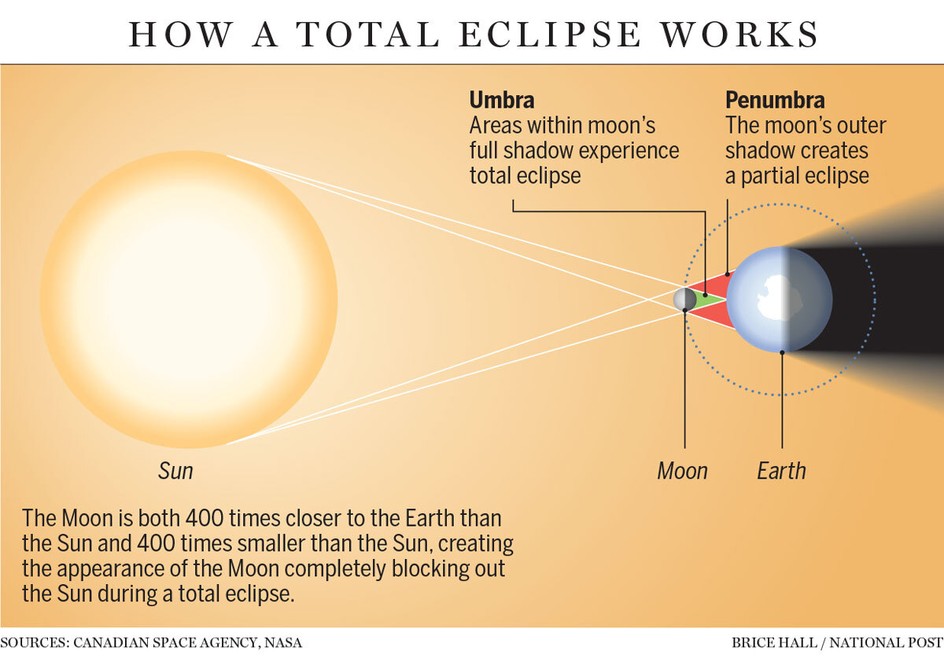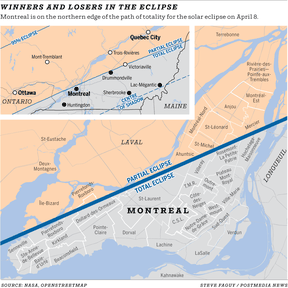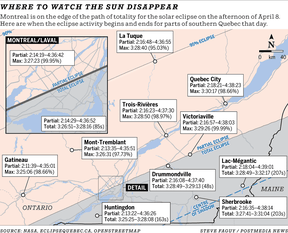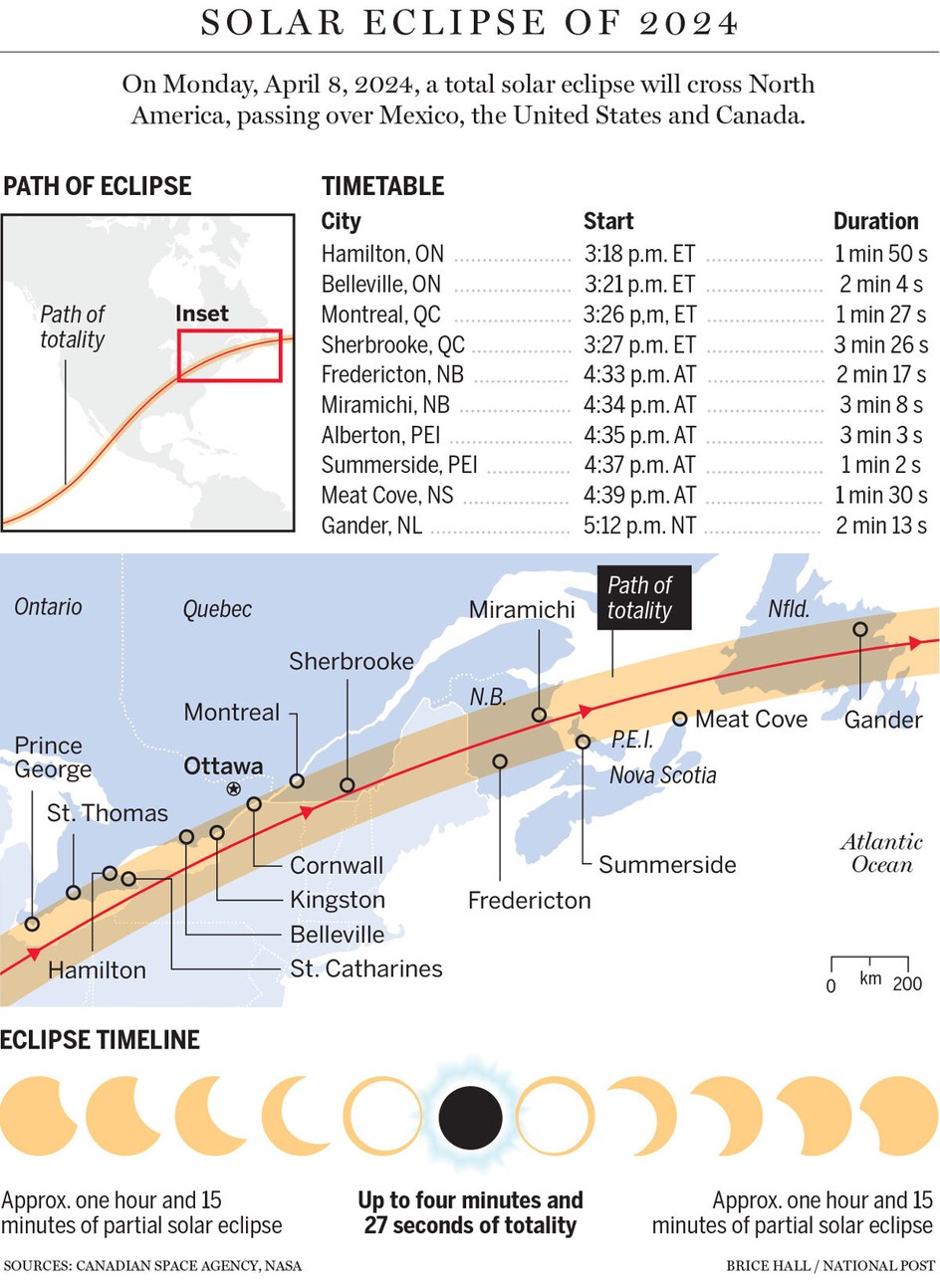Montrealers are preparing for the once-in-a-lifetime event, though only parts of the city will go totally dark.
Article content
Updated throughout the day on Monday, April 8. Questions/comments: ariga@postmedia.com
Latest updates
Article content
- Mother Nature is cooperating
- Maps: These parts of Montreal will get totally dark
- Best spots around Montreal to watch the eclipse
- Video: Here’s what you can expect to see in Montreal
- Do you really need eclipse glasses?
- Being outdoors is safe, but be cautious, Quebec says
6 a.m.
Mother Nature is cooperating
Today’s Environment Canada forecast calls for an unobstructed view of the sun.
Advertisement 2
Story continues below
Article content
Along with clear skies, the city will enjoy a high of 15 Celcius — almost double the average high for April 8.
Montrealers should count themselves lucky.
In 1932, the last time the island experienced a total solar eclipse, the skies were very cloudy, leaving skygazers grumbling.
In February 1979, Montreal was prepared for a partial eclipse, with 77 per cent of the sun expected to be covered by the moon.
The Montreal Star headline the next day: “Blizzard blocks eclipse.”

6 a.m.
Maps: These parts of Montreal will get totally dark




6 a.m.
Best spots around Montreal to watch the eclipse
You could, of course, view the total solar eclipse on your own. But the experience may be more memorable if you view it with others.
Several group eclipse-viewing events will give people that opportunity. They’re free and open to the public.
Read our full story, by Susan Schwartz.

6 a.m.
Video: Here’s what you can expect to see in Montreal
Article content
Advertisement 3
Story continues below
Article content
Advertisement 4
Story continues below
Article content
6 a.m.
Do you really need eclipse glasses?
Eclipse glasses are essential to safely watch the moon gradually move in front of the sun.
But there are other ways to view partial phases of the eclipse if you can’t get your hands on a pair — and they’re not necessary during the short period of totality when the sun is completely blocked.
Advertisement 5
Story continues below
Article content
6 a.m.
Being outdoors is safe, but be cautious
The Quebec government is offering advice to people worried about being outside during the eclipse.
“Being outdoors during a solar eclipse is not a health hazard if you’re not looking directly at the sun,” the province says. ” You can enjoy your usual outdoor activities throughout the eclipse.”
Here are some of the government’s tips:
For driving during the solar eclipse
It is safe to drive during the eclipse. However, do not allow this spectacular phenomenon to distract you while driving. Windows, even tinted ones, and the windshield of your vehicle do not afford adequate protection to watch the eclipse. Do not directly observe the sun and do not use solar eclipse glasses since they only allow you to see the sun and cannot, therefore, be worn while driving.
Do not stop your vehicle on the road or on the shoulder to watch the eclipse. You must at all times comply with the Highway Safety Code and allow emergency vehicles to circulate.
Traffic congestion and slowdowns are possible in areas where a total eclipse will be visible and near numerous assembly sites organized to observe the eclipse. Allow extra time to reach your destination. Consult the Québec 511 website or dial 511 for information on the state of the road network.
Advertisement 6
Story continues below
Article content
Heavier demand for electric vehicle charging stations is also anticipated in certain sectors. Plan recharging time for your vehicle accordingly.
If you work outdoors
To protect your health and safety, as well as your physical and psychological well-being, please observe the following recommendations if you’re an outdoor worker.
- Do not look directly at the eclipse without proper protection for the duration of the eclipse.
- For personnel who have to look up to the sky, we recommend keeping the sun out of their field of vision (e.g. standing with their backs to the sun).
- Avoid observing or photographing the eclipse through a lens (e.g. cell phone, binoculars, telescope) without a suitable solar filter. Activities with this type of equipment should be postponed until after the eclipse to limit all risks.
If you have pets or livestock
As pets are unlikely to look at the sun, the risk to their eyes is low. To minimize these risks, you can keep your pet indoors. However, your pet may become excited during the eclipse. If in doubt, consult your veterinarian.
During a solar eclipse, farm animals may sometimes react as if it were evening, adopting nocturnal behaviour (e.g., returning to the barn or stable, lying down, or eating). Others may stop their activities for a few minutes out of curiosity. As with pets, farm animals don’t tend to look at the sun, so there’s little risk of damage to their eyes.
Read more on Quebec’s eclipse page.

Recommended from Editorial
Advertisement 7
Story continues below
Article content
Article content



Comments